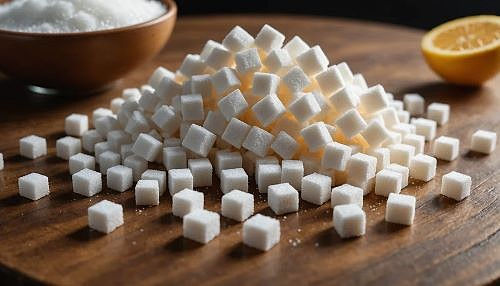Carbohydrates: Sugars of Nature & Health
- Sylvia Rose

- Feb 6
- 6 min read
Updated: Feb 8
Carbohydrates are essential macromolecules important to human health and the natural environment. They range from simple monosaccharides to complex polysaccharides, providing energy and structure to life forms.

Carbohydrates are integral to life. They influence health and take part in countless biological processes. Occurring as single, simple sugars to complex, branching chains, each has a reason for being.
All carbohydrates are composed of carbon, hydrogen, and oxygen atoms. They are generally classified based on the number of sugar molecules or saccharides they have.

Monosaccharides: Simple Sugars
Formation
Monosaccharides are the simplest type of carbohydrate, or single unlinked sugar molecules. Examples include glucose (dextrose), fructose (fruit sugar), and galactose.
These simple sugars form through photosynthesis in plants, whereby carbon dioxide and water combine with sunlight.
Structure
These are the basic building blocks, often existing as ring structures. Monosaccharides are a chain of carbon atoms with hydroxyl (-OH) groups attached. Glucose, a six-carbon molecule, forms a ring structure when mixed with water.

Functions in Humans
Glucose is the primary source of energy for cells of humans and other organisms. Fructose is found in fruits and honey, metabolized differently than glucose.
Galactose is a component of lactose, the sugar in milk. In humans, monosaccharides are an immediate energy source. Glucose, often called blood sugar, is quickly absorbed into the bloodstream.
A single gram of glucose provides about four calories of energy. This rapid absorption fuels metabolic activities. Monosaccharides are important to cellular signaling and formation of nucleic acids, which carry genetic information.

Importance to Nature & Environment
Glucose is produced by plants through photosynthesis, making it the primary energy source for nearly all life on Earth. It's the fuel for plant growth and reproduction.
In nature, these sugars form the foundation of more complex carbohydrates and are vital for energy transfer in ecological systems. They support soil fertility, enabling plant growth to sustain entire ecosystems.
Monosaccharides may be simple sugars but often exist in different isomeric forms such as alpha-glucose and beta-glucose. These influence their properties and the structures they can create.

Disaccharides - Double Sugars
Formation
Disaccharides are made when two monosaccharides join together with a glycosidic bond. They release a water molecule in a process of dehydration synthesis.
Common examples include sucrose or table sugar, made of glucose + fructose. Lactose or milk sugar is created from glucose + galactose.
Maltose or malt sugar is a double glucose. It forms during starch digestion or enzymatic reactions.

Structure
Disaccharides consist of two bonded monosaccharide units linked by an oxygen atom. The arrangement of these units defines the disaccharide's properties.
Functions in Humans
Sucrose is a readily available energy source. Lactose provides energy for infants, digested by the enzyme lactase. Maltose is a quick fix for fatigue but can cause blood sugar spikes. It's an essential sugar in beer brewing.
In humans, disaccharides provide energy source but must be reduced to monosaccharides during digestion. One tablespoon of sucrose has about 48 energy calories when hydrolyzed to glucose and fructose in the intestine.

Importance to Nature & Environment
In nature, disaccharides provide energy to various organisms. Sucrose is the main transport form of carbohydrates in plants, delivering energy-rich compounds to growth areas where they're needed.
Oligosaccharides: Short Chains
Formation
Oligosaccharides consist of 3 to 10 monosaccharide units linked together. They are found in many natural sources, such as legumes, onions, and garlic.
These carbohydrates form during plant metabolism. Multiple monosaccharides combine to bring them into existence.

Structure
These are shorter chains than polysaccharides and function in cell recognition and signaling. The structures of oligosaccharides can vary greatly, forming branches and different configurations. Their specific arrangements influence their solubility and how easily they're digested.
Functions in Humans
Some oligosaccharides, like fructooligosaccharides (FOS), are prebiotics, promoting the growth of beneficial bacteria in the GI tract. They also help absorb minerals, and can enhance immune function.

Human milk oligosaccharides (HMOs) are a diverse group of oligosaccharides found in breast milk, providing numerous benefits to infants, including immune system development.
Importance to Nature & Environment
They exist in plant cell walls, part of plant-microbe interactions. In ecology oligosaccharides contribute to nutrient cycles as energy sources for soil and aquatic microbial communities. This nutrient input is needed for ecosystem health.

Polysaccharides: The Long Polymers
Formation
Polysaccharides are complex carbohydrates formed by the linking of hundreds or thousands monosaccharide units. Polysaccharides are large molecules.
Examples include starch, cellulose, and glycogen. These carbohydrates form through enzymatic linkage of simpler sugars during energy storage or structural formation.

Structure
These can be linear or branched polymers such as:
Starch: The primary energy storage molecule in plants, composed of amylose (linear) and amylopectin (branched) chains of glucose.
Glycogen: The energy storage molecule in animals, a highly branched polymer of glucose.
Cellulose: The primary structural component of plant cell walls, composed of long, linear chains of glucose.
Chitin: A structural polysaccharide found in the exoskeletons of insects and crustaceans, composed of N-acetylglucosamine.

Functions in Humans
Starch is a major source of dietary energy. Glycogen is stored in the liver and muscles for quick energy release. Cellulose provides dietary fiber, promoting healthy digestion.
In humans, polysaccharides give sustained energy release. In digestion, they break down to monosaccharides and are absorbed into the bloodstream. Gradual release helps maintain stable blood sugar levels.

Importance to Nature & Environment
Polysaccharides are vital in nature. Cellulose is the most abundant organic molecule on Earth, providing structural support to plants and significant in the carbon cycle.
Chitin functions in nutrient cycling in marine and terrestrial ecosystems. Starch releases energy to plant seeds and tubers. Cellulose supports plant structure, improves soil quality and moisture retention.

Humans lack the enzyme cellulase, needed to break down cellulose. This is why people can't digest grass or wood, but forms of these are important dietary fiber.
Termites have symbiotic microorganisms living in their digestive systems. The microbes produce cellulase, allowing the insects to digest wood.
Breaking Down the Complexes: Hydrolysis
To use the energy stored within disaccharides, oligosaccharides, and polysaccharides, bodies must reduce them to monosaccharides. This is accomplished through the process of hydrolysis.

Hydrolysis adds a water molecule to break the glycosidic bond between the sugar units. Enzymes, such as amylase for starch, sucrase for sucrose, and lactase for lactose catalyze these reactions.
This process occurs mainly in the mouth and small intestine. During digestion, polysaccharides first hydrolyze into disaccharides and oligosaccharides.
These smaller units subsequently break down into monosaccharides like glucose and enter the bloodstream. This is needed for balance of energy. It regulates blood sugar and supports physical and mental health.

Cell Recognition
Glycoproteins and glycolipids are carbohydrates attached to proteins and lipids, respectively, on cell surfaces play crucial roles in cell communication, immune responses, and tissue development.
Prebiotics
Certain oligosaccharides and resistant starches are prebiotics, nourishing beneficial bacteria in the GI tract to improve digestive health. Good digestion is important to overall wellness of body and mind.

Non-Fiction Books:
Fiction Books:
READ: Lora Ley Adventures - Germanic Mythology Fiction Series
READ: Reiker For Hire - Victorian Detective Murder Mysteries


